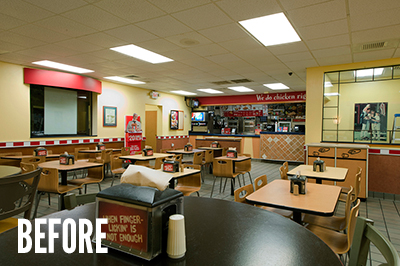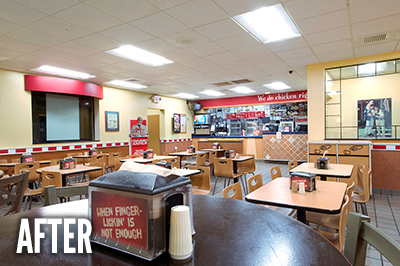Now is the Time for LED
Published in Retail & Restaurant Facility Business Magazine
Download PDF
By Laura Lockton of BioStar Renewables
It might be the best and brightest decision you make.
Imagine upgrading your stores, giving them a fresh look and saving energy at the same time. What if the transformation didn’t raise your business costs? Now it’s possible with LED lighting. The energy savings will more than pay for the cost of the upgrade.
The idea of LED lighting is not new in the restaurant and retail market. Owners and franchisees recognize that LED lighting will lower electricity and maintenance costs, helping businesses become more profitable and sustainable. Upgrading to LED lighting also gives their stores a fresh, modern look through an increased quality of light. Simply stated, LEDs offer better light, longer life and lower costs.
LED lighting is more affordable than ever; now it is an investment that is hard to ignore. Between lower costs, higher energy savings, utility rebates and new programs that make upgrading easy and affordable, now is the time for LEDs.
A Bright Idea Makes a Big Difference
LED lights offer a brilliant aesthetic, while at the same time lowering lighting energy use by 50% to 90%. Restaurants use five to seven times more energy per square foot than office buildings or retail stores, with quick-service restaurants using up to 10 times more, according to industry estimates. At the same time, the constant maintenance and bulb replacement that comes with traditional lighting is necessary and costly. Rising electricity costs and growing environmental concerns from consumers mean that energy efficiency is a top concern for owners and franchisees.
So why is there such a big difference in energy use and longevity when upgrading to LEDs? Only about 5% of the energy consumed by an incandescent bulb gets converted to visible light. Much of the energy is converted to heat, further increasing HVAC energy use and costs. Furthermore, an incandescent bulb has a short lifespan average of 2,000 hours, so the burned out bulb is a constant hassle.
In contrast, about 95% of the energy that an LED light consumes gets converted to visible light. Energy loss from heat output and noise is drastically reduced. LED lights last 50,000 to 150,000 hours, with average lifetimes of 10 to 15 years in a restaurant or retail environment, so they are virtually maintenance-free. That is five times longer than the average fluorescent bulb, and up to 30 times longer than incandescent bulbs. The combination of energy and maintenance savings often reduces lighting costs by at least 75%, eliminating thousands of dollars in expenses per store.
Improved lighting color and more light per watt means that LEDs deliver much more reliable, appealing light. The lights are made with solid state components, so they are much less fragile, and the quality of light does not degrade quickly. On the other hand, fluorescent lights tend to change color and flicker as the lights and fixtures age. The light from LEDs also travels farther, providing better coverage and reducing dark areas produced by halogens and fluorescents. So upgrading to LEDs gives stores and restaurants an updated look, and drastically reduces maintenance concerns and energy use.
The Question Is No Longer Why – The Question Now Is How
Though they understand the benefits of LED lighting, many restaurant owners and franchisees face the challenge of how to find the capital to execute upgrades across their locations. The process of picking the right fixtures and lamps, with the right amount of light, in the right color and with the right warranty is challenging. The lights last for a decade, so getting it right the first time is paramount and best handled by a professional lighting design team.
Ray Aley of White Management operates over 25 quick-service restaurants of different brands in upstate New York. He recently decided to upgrade to LED lighting. After experimenting with LED lights at some of his properties, he was very pleased with the new look and energy savings.
Like many owners and franchisees, Aley was looking for a partner to guide him through the entire process. He chose a national provider of turnkey LED lighting solutions. He was happy to have their team of experts to manage the projects from start to finish, eliminating the common questions of what products, what wattages, how many lights, and how to install them. Plus they provided him a better way to pay for the upgrade.
A new EnergyShare program was introduced to solve the question of how. The program is designed to make professional LED lighting upgrades easy, affordable, and immediately cash flow positive. At its core, EnergyShare provides an operating lease requiring no initial capital investment, coupled with professional lighting design and installation. It is designed so that the energy and operational savings more than pay for the LED upgrade, and a share of that savings is passed on to the building or business owner.
EnergyShare makes it easy for multi-location owners and franchisees to roll out an LED lighting solution across their portfolio of properties.
Aley was impressed with the simplicity of executing installations across multiple stores and the lack of capital required, in addition to the energy audit and design services provided.
“In addition to the cost savings, I love the clean look of LED and how it gives my stores more vibrancy,” he explains. “It was an easy decision to upgrade the lighting in my stores.”
An LED Strategy Turns Expenses Into Valuable Assets
White Management has begun the process of upgrading all the lighting at their properties with a selection of five restaurants: four Dunkin’ Donuts and one KFC/Taco Bell. After upgrading all interior and exterior lights, the energy savings are remarkable. The electricity demand from lighting is reduced by 22.3 kW, eliminating 97,700 kWh of electricity used per year. This lowers lighting electric costs by an average of 60% and eliminates maintenance and bulb replacement costs.
By utilizing the EnergyShare operating lease, businesses can be cash flow positive from day one. Utility rebates helped Aley offset 30% of the project costs. After EnergyShare payments for the balance of the projects, Aley will save $29,964 over the first 5 years after the LED lighting upgrades of his first 5 stores. Over the lifetime of the lights, which average 13.7 years, he will save $190,000.
On top of these energy and maintenance savings, Aley will further improve his bottom line because of the tax advantages of the EnergyShare operating lease. Payments are treated as a tax deductible operating expense, offsetting income and reducing taxes.
An operating lease is treated like renting, and lease payments are considered operational expenses, eliminating long depreciation schedules for lighting. No debt is shown on the balance sheet, simplifying accounting and reporting and improving the value of the business. The tax advantages of operating leases are especially significant for fixed assets such as lighting that are generally depreciated over a long term. Operating leases also make it possible for some businesses to claim a significant abandonment deduction for removing the old fixtures. Because of the tax advantages, in many cases the net cost of a lighting upgrade is less with an operating lease than paying cash upfront! So the operating lease is the ideal financing solution, turning a cost into a valuable asset.
Now upgrading to LED lighting not only improves profitability and sustainability; utilizing a program like EnergyShare provides flexibility, simplicity, and an improved return on investment (ROI) without capital budgeting restraints. According to Aley:
“The lights really do pay for themselves, and I am excited about that!”
— Laura Lockton is the marketing director of BioStar Lighting, a national provider of turnkey LED lighting solutions headquartered in the Kansas City metropolitan area. Restaurants working with BioStar include KFC, Taco Bell, A&W Restaurants, Arby’s, Dunkin’ Donuts and Subway. Email the author at [email protected].




